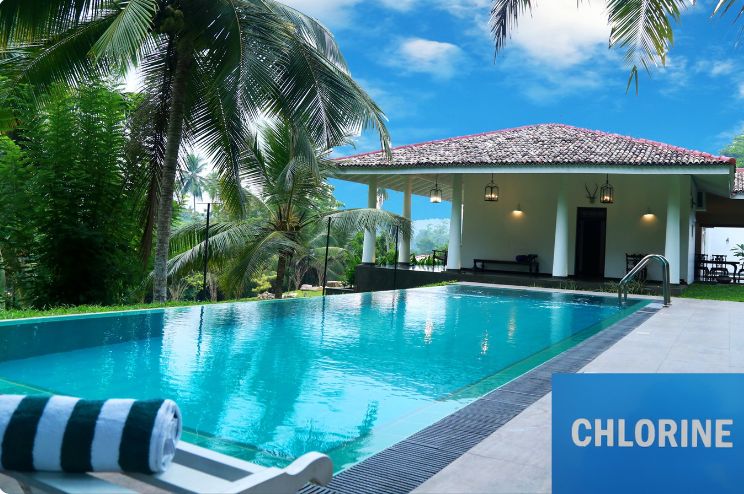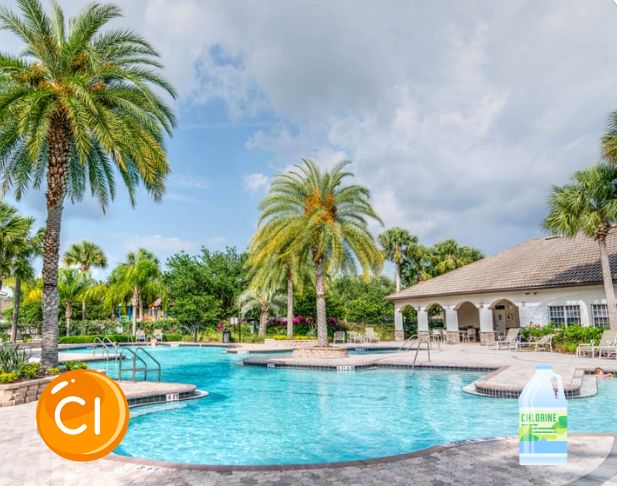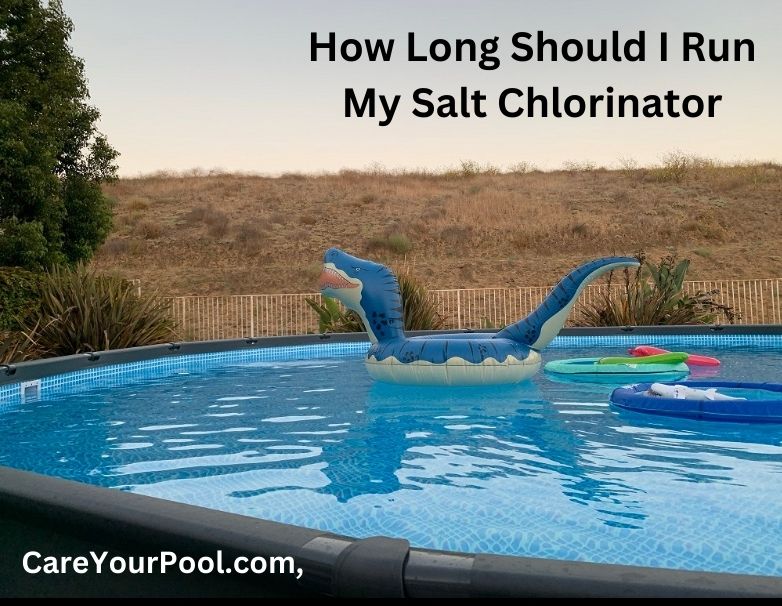Your family’s health as well as your own depends greatly on the purity of your water. To help protect you from dangerous bacteria in the water you switch on at home, you can use an interior or external salt chlorinator. Pool owners who have a pool at home need external salt chlorinators to work on it.
As a pool owner, it’s a troublesome question How long should I run my salt chlorinator? As you are aware, the quantity of salt applied determines how much water is in the pool.
There are also questions like how to add salt to pool with salt water chlorinator that bothers pool owners. But you can look for them later in our site.
There are a lot of factors that you need to take into account, such as determining your pool’s chlorine demand, the size of your pool, the temperature, sunlight, etc. Then you need to find the correct runtime.
During the busiest diving season, you should operate your chlorinator for 8 to 12 hours daily, and in the off-season, 4-6 hours. However, depending on the demand for chlorine in your pool and other variables, you might need to modify this.
What is your Pool’s Chlorine Demand?
Understanding your pool’s chlorine consumption is necessary before deciding how long to operate your salt chlorinator.
The quantity of chlorine needed to sanitize the water and maintain the correct amounts is known as the “chlorine demand,” and it can change depending on the weather, sunlight, bather traffic, and contaminants like leaves and detritus.
You must routinely test the water using a dependable water testing tool to determine your pool’s chlorine demand. By doing so, you can keep an eye on the chlorine levels and modify the salt chlorinator as necessary.
For the best pool health and protection, aim for a chlorine level of 1-3 parts per million (ppm).
Factors You Have to Consider for Chlorinator Runtime
You can take into account the variables that influence how long to operate your salt chlorinator once you are aware of the chlorine demand for your pool. These factors consist of:
Pool Size:
If your pool is bigger, you may need to operate your chlorinator for extended periods of time because bigger pools need more chlorine.
Bather Load:
As more people use your pool, more pollutants build up, and you’ll need more chlorine to keep the levels balanced.
Temperature:
In warmer weather, you might need to run your chlorinator for longer periods of time because higher temperatures can speed up chlorine loss.
Sunlight:
Since sunlight’s ultraviolet (UV) rays can also degrade chlorine, running your chlorinator for extended amounts of time during prime sunlight hours may be necessary.
Weather:
Rain, wind, and storms can all impact the chlorine consumption in your pool and change the amount of time your chlorinator needs to operate.
What Should Be Your Ideal Chlorinator Runtime
You can modify the duration of your chlorinator in accordance with the aforementioned variables. During the busiest diving season, you should operate your chlorinator for 8 to 12 hours daily, and in the off-season, 4-6 hours. However, depending on the demand for chlorine in your pool and other variables, you might need to modify this.
It’s crucial to remember that operating your chlorinator for an excessive amount of time can cause high chlorine levels, which can endanger swimmers and hurt pool apparatus. On the other hand, operating your chlorinator too quickly can lead to insufficient chlorine levels, which can encourage the growth of germs and algae.
Regularly check the amount of chlorine in your pool and, as necessary, modify the duration of your chlorinator. Consult your salt chlorinator’s manual or get in touch with the manufacturer for precise instructions if you’re uncertain how long to operate it for.
How Long Should I Run My Salt Chlorinator?
To help you with your chlorinator’s runtime, we have perfected a chart for you. We hope you’ll get a good idea of how much your runtime should be according to your pool’s chlorine demand:
| Chlorine Demand | Required Chlorinator Runtime |
| 0.5 ppm (Low) | 4-6 hours per day |
| 1.0 ppm (Moderate) | 6-8 hours per day |
| 1.5 ppm (High) | 8-12 hours per day |
| 2.0 ppm | 10-14 hours per day |
| 2.5 ppm | 12-16 hours per day |
| 3.0 ppm | 16-20 hours per day |
It’s essential to remember that your pool’s particular chlorine needs can change depending on things like utilization, weather, and the presence of pollutants.
You can determine the right amount of chlorine your pool needs by conducting regular water tests by professionals, and by adjusting the chlorinator runtime appropriately, you can help keep the right amount of chlorine in your pool water. That’s why you need to learn how to test a salt chlorinator.
An expert pool advisor can offer more detailed advice based on the requirements of your particular pool.
The Importance of Chlorine Levels for Pool Water Safety and Maintenance

The amount of chlorine generated by a seawater chlorinator can differ depending on its output setting, the size of the pool, and the level of chlorine demand in the water, which is why a pool may need 4-6 hours of chlorinator runtime per day to maintain a 0.5 ppm (parts per million) chlorine level.
The lowest safe amount of chlorine for keeping pool water sanitized is typically 0.5 ppm. Low chlorine content or no chlorine at all in the pool water can promote the growth of dangerous bacteria and other pollutants, posing health dangers and resulting in poor water quality.
A seawater chlorinator must produce enough chlorine to counteract the chlorine demand in the water in order to sustain a 0.5 ppm chlorine level in a pool.
The length of time the chlorinator must run to accomplish this can change depending on the aforementioned elements, but it typically ranges between 4-6 hours per day.
It’s important to remember that this value is only an estimate, and the actual runtime of the chlorinator needed for your pool may be higher or lower depending on its requirements.
You can determine the right amount of chlorine your pool needs by conducting regular water tests, and by adjusting the chlorinator runtime appropriately, you can help keep the right amount of chlorine in your pool water.
Consulting with a pool professional can also provide more specific guidance based on your individual pool’s needs.
2.0 ppm (parts per million) of chlorine is on the upper end of the advised range, but it can be suitable for a swimming pool. A swimming pool should usually have chlorine amounts in the range of 1.0 to 3.0 ppm.
A greater chlorine concentration, like 2.0 ppm, can aid in keeping your pool clean and clear of dangerous germs and other contaminants.
However, it’s crucial to stay within the advised range since greater chlorine concentrations can aggravate athletes’ skin, eyes, and respiratory systems.
It’s also crucial to remember that keeping the proper amount of chlorine in a pool is not the only thing that goes into making sure the water is safe and healthy. Important elements of pool care include proper pH and alkalinity levels, routine cleansing and upkeep, and frequent water testing.
Consult with a pool expert who can offer advice and support based on the specific requirements of your pool if you’re uncertain of the right chlorine level for your pool or if you’re having problems with pool water quality or upkeep.
How Long Should I Run My Salt Chlorinator in Winter

Your local environment, the size of your pool, and the present quality of your pool’s water will all have an impact on how long you should leave your salt chlorinator running during the winter.
Even if you don’t use your pool frequently during the winter, it’s generally advised to keep your salt chlorinator running for at least 4-6 hours each day. This will support preserving the ideal chlorine levels and maintaining the pool’s sanitization.
However, if you reside in a region where winter temperatures routinely dip below zero, it might be necessary to cut back on the amount of time your chlorinator runs or even turn it off completely. This is due to the possibility that the water in your pool could freeze and harm the pipes or machinery.
It’s crucial to frequently test your pool water to make sure the chlorine levels are within the recommended range before making any adjustments to the salt chlorinator’s runtime during the winter.
You might also want to speak with a pool expert who can advise you on the ideal runtime for the circumstances of your particular pool and environment.
What if: Not running your Salt Chlorinator long enough
Your pool water may not be properly sanitized if your seawater chlorinator isn’t operated for a long enough period of time. For the water in swimming pools to be free of dangerous germs and other microbes, chlorine is necessary.
These microbes can grow if there is not enough chlorine present, which could lead to divers getting sick or experiencing other health issues.
Additionally, low chlorine levels can encourage the development of algae, which will obscure the water in your pool and make it look unattractive.
Once it has established itself in your pool, algae can be challenging to get rid of and may require extra chemicals and scrubbing. That’s why you need to learn how to use algaecide and how does algaecide work.
It’s essential to test your pool water frequently to make sure the chlorine levels are within the recommended range and to operate your saltwater chlorinator according to the manufacturer’s instructions.
The length of time required to operate your chlorinator will rely on variables such as the size of your pool, the amount of utilization it gets, the level of sunshine, and other external factors that can influence water quality.
You can make sure that your pool water is pure and suitable for swimming by operating your saltwater chlorinator for the advised period of time. If you’re not sure how long to operate your chlorinator for, ask a pool expert for advice based on the demands of your particular pool.
Before you leave
If you don’t intend to use the pool for a while, running the salt chiller for 12 hours might be a preferable option. Running the salt chiller for 24 hours will guarantee that there is no extra chloramine left in the water.
Test the water to make sure the chloramine has been sufficiently removed. Your swimming pool ought to be clean and usable. You can get in touch with us if you have any queries.
You can check the amounts of chloramine using a swimming pool water meter, but it’s crucial to confirm that they are at 0 ppm. A straightforward test strip will work just fine if you don’t have one.
If you still have high levels, it may be time to call a professional. If you still have a reading above 200, repeat the process until it’s at zero.
And if you have any further queries like how to use suction pool cleaner, feel free to roam around our site.
Read more, Learn more
- How to paint above-ground pool rails?
- How to install saffron pool rails?
- How do pool alarms work?
